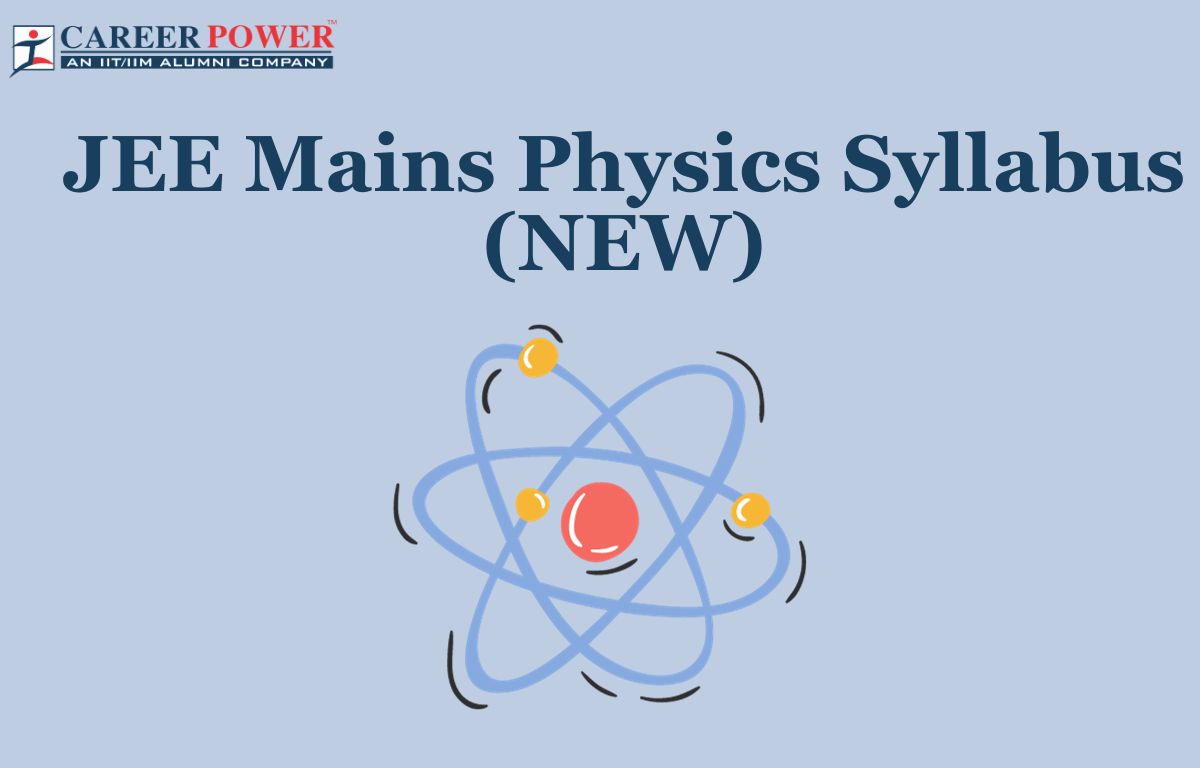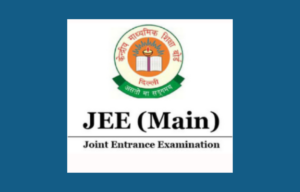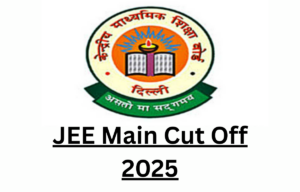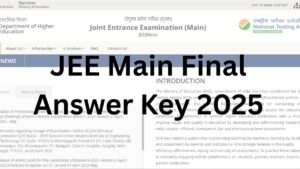The National Testing Agency has released the complete JEE Mains Syllabus 2025 on its official website i.e., www.jeemain.nta.ac.in. The students can check the latest JEE Mains Physics Syllabus 2025 in online mode. Students can also check the Physics syllabus PDF below. With the release of the latest syllabus, NTA has also released the JEE Mains 2025 Application form on October 28 at its official website. The JEE Mains Physics Syllabus has been changed. The Changed Physics syllabus has been mentioned below.
JEE Main Physics Syllabus
The National Testing Agency will conduct the JEE Mains 2025 Exam in two sections: January and April. The JEE Main Exam Date 2025 for session 1 is scheduled between January 22 and January 31, 2025. According to the JEE Main Exam Pattern, the Joint Entrance Examination (JEE Main) comprises two papers: Paper 1 and Paper 2.
Paper 1 (B.E./B.Tech.) is conducted for admission to Undergraduate Engineering Programs (B.E/B. Tech) at NITs, IIITs, other Centrally Funded Technical Institutions (CFTIs), Institutions/Universities funded/recognized by participating State Governments. It is also an eligibility test for JEE (Advanced), which is conducted for admission to IITs. Paper 2 is conducted for admission to B. Arch and B. Planning courses in the Country.
JEE Mains Syllabus 2025 for Physics
The JEE Main Syllabus 2025 for Physics consists of all the topics from CBSE Class 11 and CBSE Class 12 physics syllabus. The Physics syllabus is divided into two sections: Sections A and B. Where Section A is a theory part, and has a weightage of 80%, while Section B consists of Practical components or experimental skills having a 20% weightage in the exam.
JEE Mains 2025 Physics Syllabus for Section-A
Physics is an important subject for the JEE Mains 2025 exam, covering 21 units, each with its own topics. Since questions usually come from every unit, students need to study all the units carefully. The updated syllabus for JEE Mains 2025 Physics is listed in a table below, showing the key topics that are most important for Section A, which deals with theory-based questions. It’s essential to focus on these topics for better preparation.
| JEE Main 2025 Physics Syllabus: Section A |
|
| Units | JEE mains Physics Syllabus Topics |
| Physics and Measurement | Physics, technology, and society, SI Units, fundamental and derived units, least count, accuracy and precision of measuring instruments, Error, and measurement, Dimensions of Physics quantities, dimensional analysis, and its applications. |
| Kinematics | Frame of reference, Motion in a straight line: Position-time graph, speed, and velocity. Uniform and non-uniform motion, average speed and instantaneous velocity Uniformly accelerated motion, velocity-time, position-time graphs, and relations for uniformly accelerated motion. Scalars and Vectors, Vector addition and Subtraction, Zero Vector, Scalar and Vector products, Unit vector, and Resolution of a vector. Relative velocity, Motion in a plane.Projectile motion, Uniform Circular Motion. |
| Laws of Motion |
|
| Work, Energy, and Power |
|
| Rotational Motion | Centre of mass of a two-particle system, Centre of mass of a rigid body; Basic concepts of rotational motion; moment of a force, torque, angular momentum, conservation of angular momentum and its applications; moment of inertia, radius of gyration.Values of moments of inertia for simple geometrical objects, parallel and perpendicular axes theorems and their applications. Rigid body rotation, equations of rotational motion. |
| Thermodynamics | Thermal equilibrium, zeroth law of thermodynamics, concept of temperature. Heat, work, and internal energy. The first law of thermodynamics. The second law of thermodynamics: reversible processes. Carnot engine and its efficiency. |
| Properties of Solids and Liquids | Elastic behavior, stress-strain relationship, Hook’s Law, Young’s modulus, bulk modulus, modulus of rigidity. Pressure due to a fluid column; Pascal’s law and its applications. Viscosity, Strokes’ law, terminal velocity, streamline and turbulent flow, Reynolds number. Bernoulli’s principle and its applications. Surface energy and surface tension, angle of contact, application of surface tension drops, bubbles and capillary rise. Heat, temperature, thermal expansion; specific heat capacity, calorimetry; change of state, latent heat. Heat transfer-conduction, convention and radiation, Newton’s law of cooling. |
| Gravitation | The universal law of gravitation. Acceleration due to gravity and its variation with altitude and depth, Kepler’s law of planetary motion. Gravitational potential energy; gravitational potential. Escape velocity. Orbital velocity of a satellite.Geo-stationary satellites. |
| Kinetic Theory of Gases | Equation of state of a perfect gas, work done on compressing a gas. Kinetic theory of gases-assumptions, the concept of pressure. Kinetic energy and temperature: rms speed of gas molecules; Degrees of freedom, Law of equipartition of energy, applications to specific heat capacities of gases; Mean free path, Avogadro’s number. |
| Oscillations and waves | Periodic motion-period, frequency, displacement as a function of time. Periodic functions. Simple harmonic motion (S.H.E) and its equation; phase; oscillations of a spring-restoring force and force constant; energy in S.H.E. – kinetic and potential energies; simple pendulum-derivation of expression for its time period; Free, forced, and damped oscillations, resonance. Wave motion. Longitudinal and transverse waves, speed of wave. Displacement relation for a progressive wave. Principle of super possessive waves, Standing waves in strings and organ pipes, fundamental mode and harmonics, Beats, Doppler effect in sound. |
| Electrostatics |
|
| Current Electricity |
|
| Magnetic Effects of Current and Magnetism |
|
| Electromagnetic Induction and Alternating Currents | Electromagnetic induction; Faraday’s law, induced emf and current; Lenz’s law, Eddy currents. Self and mutual Inductance. Alternating currents, peak and rms value of alternating current/voltage; reactance and impedance; LCR series circuit, resonance; Quality factor, power in AC circuits, wattless current. AC generator and transformer. |
| Electromagnetic Waves |
|
| Optics | Reflection and reflection of light at plane and spherical surfaces, mirror formula, total internal reflection and its applications, Deviation and dispersion of light by a prism, Lens formula, magnification, Power of a lens, the combination of thin lenses in contact, Microscope and Astronomical Telescope (reflecting and refracting) and their magnifying powers. |
| Wave Optics | Wavefront and Huygen’s principle, Laws of reflection and refraction using Huygen’s principle. Interference, Young’s double slit experiment and expression for fringe width, coherent sources and sustained interference of light. Diffraction due to a single slit, width of central maximum. Resolving power of microscopes and astronomical telescopes, Polarisation, plane polarized light; Brewster’s law, uses of plane polarized light and polaroids. |
| Dual Nature of Matter and Radiation | Dual nature of radiation. Photoelectric effect, Hertz and Lenard’s observations; Einstine’s photoelectric equation; particle nature of light. Matter waves-wave nature of particle, de Broglie relation. Davis son-Germer experiment. |
| Atoms and Nuclei | Alpha-particle scattering experiment; Rutherford’s model of atom; Bohr model, energy levels, hydrogen spectrum. Composition and size of nucleus, atomic masses, isotopes, isobars; isotones.
Radioactivity-alpha, beta and gamma particles/rays and their properties; radioactive decay law. Mass-energy relation, mass defect; binding energy per nucleon and its variation with mass number, nuclear fission and fusion. |
| Electronic Devices | Semiconductors; semiconductor diode: I-V characteristics in forward and reverse bias; diode as a rectifier; 1-V characteristics of LED, photodiode, solar cell and Zener diode; Zener diode as a voltage regulator. Junction transistor, transistor action, characteristics of a transistor; transistor as an amplifier (common emitter configuration) and oscillator. Long gates (OR, AND, NOT, NAND and NOR). Transistor as a switch. |
| Communication Systems | Propagation of electromagnetic waves in the atmosphere; sky and space wave propagation, need for modulation, amplitude and frequency modulation, bandwidth of signals, bandwidth of transmission medium, basic elements of a communication system (Block Diagram only). |
JEE Mains 2025 Physics Syllabus for Section-B
Students can refer to the JEE Mains 2025 Physics syllabus for the Physics Section B exam. The syllabus includes all the important topics related to practical-based questions. A table provided below lists these topics, helping students focus on what they need to prepare for the exam. By reviewing this table, students can ensure they cover all the essential areas required for Physics Section B of the JEE Mains 2025 exam.
| JEE Main 2025 Physics Syllabus: Section B |
|
| Units | Topics |
| Experimental Skills |
Potentiometer-
|
JEE Main 2025 Deleted Topics of Physics
As the National Testing Agency has also released the JEE Main 2025 deleted topics of physics, the students are advised to carefully go through the complete JEE Main updated syllabus. The table mentioned below covers almost all the topics that are deleted from the JEE Main Physics syllabus for the session 2024-25. This table will help the students to focus on the important topics and will also help them with time management.
| JEE Mains 2025 Deleted Topics of Physics | |
| UNIT | Topics |
| Unit 1 – Physics and Measurements | Physics |
| Technology | |
| Society | |
| Accuracy and precision of measuring instruments | |
| Unit 6 – Gravitation | Geostationary satellites |
| Unit 7 – Properties of Solids and Liquids | Reynolds number |
| Newton’s law of cooling | |
| Unit 8 – Thermodynamics | Carnot engine and its efficiency |
| Unit 10 – Oscillations and Waves | Free, forced and damped oscillations |
| Resonance | |
| Beats | |
| Doppler Effect in sound | |
| Unit 12 – Current Electricity | Resistances of different materials |
| Colour code for resistors | |
| Potentiometer – principle and its applications | |
| Unit 13 – Magnetic Effects of Current and Magnetism | Cyclotron |
| Magnetic susceptibility and permeability | |
| Hysteresis. | |
| Electromagnets and permanent magnets | |
| Unit 14 – Electromagnetic Induction and Alternating Currents | Quality factor |
| Unit 16 – Optics | Lens Formula |
| Resolving power of microscopes and astronomical telescopes | |
| Unit 17 – Dual Nature of Matter and Radiation | Davisson-Germer experiment |
| Unit 18 – Atoms and Nuclei | Isotopes, isobars, isotones |
| Radioactivity- alpha. beta and gamma particles/rays and their properties; radioactive decay law | |
| Unit 19 – Electronic Devices | Junction transistor |
| Transistor action | |
| Characteristics of a transistor | |
| Transistor as an amplifier (common emitter configuration) and oscillator. Transistor as a switch | |
| Unit 20: Communication Systems | Propagation of electromagnetic waves in the atmosphere |
| Sky and space wave propagation | |
| Need For Modulation | |
| Amplitude and Frequency Modulation | |
| Bandwidth Of Signals | |
| The bandwidth of Transmission medium | |
| Basic Elements of a Communication System | |
| Unit 21 – Experimental Skills | Plotting a cooling curve for the relationship between the temperature of a hot body and time |
| Characteristic curves of a transistor and finding current gain and voltage gain | |
| Using a multimeter to: (i) Identify the base of a transistor (ii) Distinguish between NPN and PNP type transistor (iii) See the unidirectional current in case of a diode and an LED. (iv) Check the correctness or otherwise of a given electronic component (diode, transistor, or IC) | |
Most Important Topics of Physics For the JEE Main 2025
Knowing the most important topics of Physics for the JEE Main 2025 examination helps the students to focus on their study efforts effectively. As it ensures the students to cover high-weightage areas. It maximizes their chance of scoring well by prioritizing the key concepts and optimizing their time and energy at the time of preparation. Here we have mentioned some of the important topics of physics that will help the students in their preparation.
- Mechanics
- Electricity and Magnetism
- Fluid Mechanics and Thermal
- Oscillation and Waves
- Optics
- Modern Physics
Books For JEE Main 2025 Physics Preparation
To prepare well for JEE Main Mathematics, good books are very helpful. The best books explain important topics like algebra, calculus, and geometry in simple ways. They have clear explanations, examples, and plenty of practice questions. These books make it easier for students to understand concepts and improve their problem-solving skills.
- Concepts of Physics by H.C. Verma – This book is great for building a strong foundation and has clear explanations.
- Fundamentals of Physics by Halliday, Resnick, and Walker – It covers a wide range of topics and is helpful for in-depth understanding.
- Problems in General Physics by I.E. Irodov – This book is excellent for challenging problems and advanced preparation.
- DC Pandey Series – A set of books focused on JEE with numerous practice questions and detailed solutions.
- Understanding Physics by D.C. Pandey – Another great series that explains concepts clearly and provides a variety of problems.
- NCERT Physics – Essential for basic concepts and aligns with the JEE syllabus.



 JEE Main 2026 Registration (Session 1)...
JEE Main 2026 Registration (Session 1)...
 JEE Main Cut Off 2025 Out: Check General...
JEE Main Cut Off 2025 Out: Check General...
 JEE Main Final Answer Key 2025 - NTA Res...
JEE Main Final Answer Key 2025 - NTA Res...













